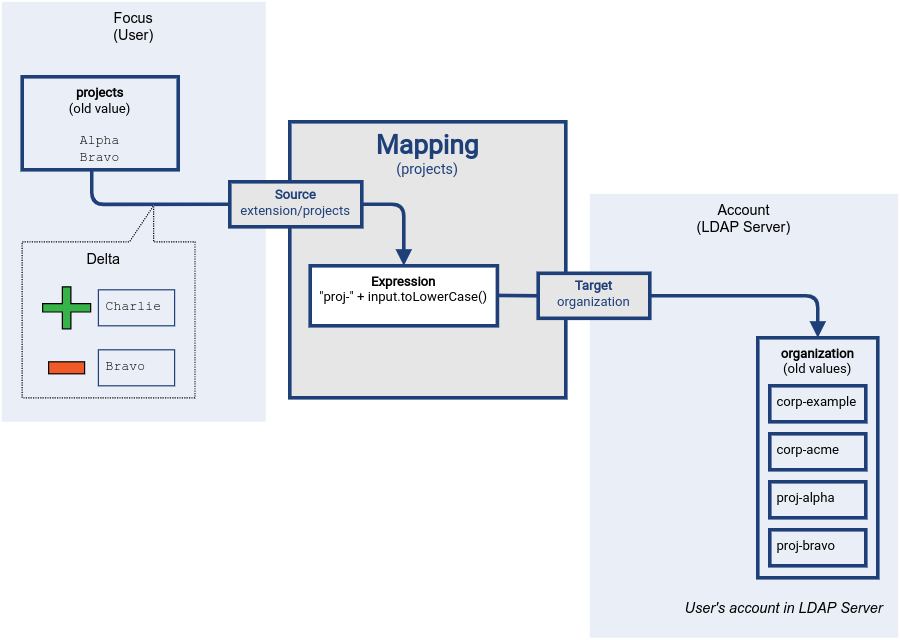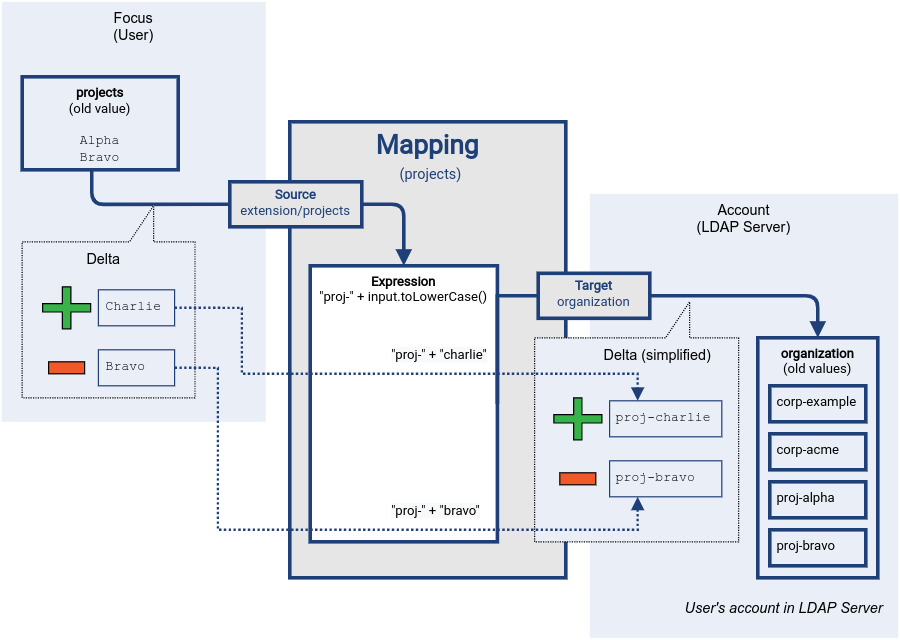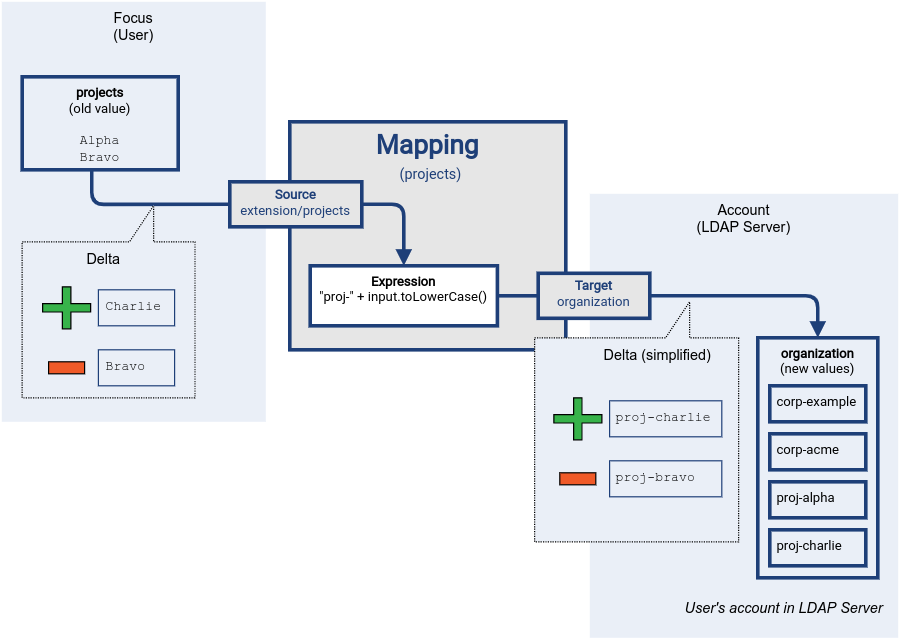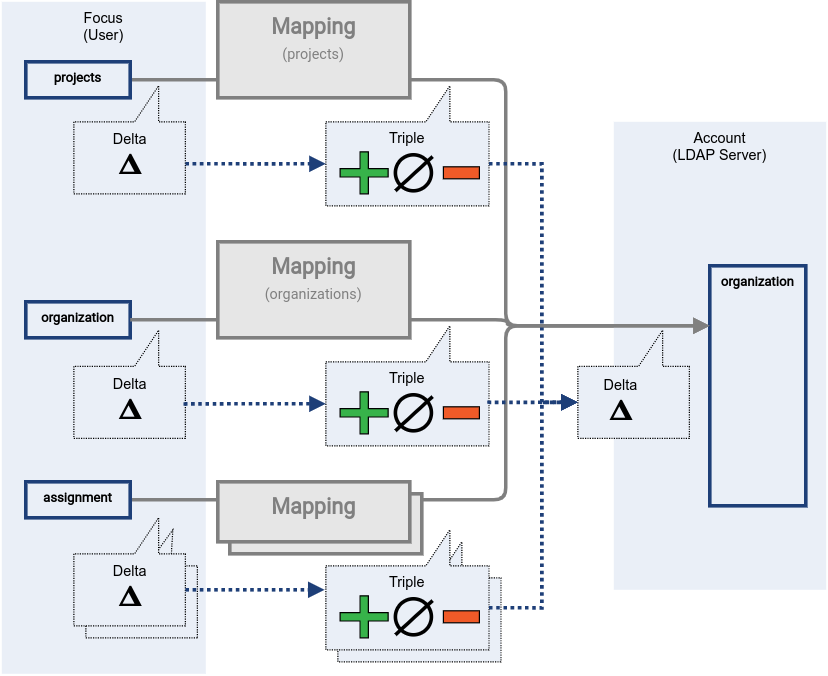<resource>
<name>LDAP Server</name>
...
<attribute>
<ref>ri:organization</ref>
<outbound>
<source>
<path>extension/projects</path>
</source>
<expression>
<code>
"proj-" + input.toLowerCase()
</code>
</expression>
</outbound>
</attribute>
...
</resource>Mapping Relativity
Motivation
Mapping inputs are provided by sources and variables, which both are represented as regular variables in mapping expressions.
Every programmer knows what a variable is.
However, variables are usually too simple to handle the relative change model used in midPoint.
In midPoint we do not just need to know that user property organization has a values foo and bar. What we need to know is that before the operation there was a value of foo.
Even more important is to know the currently processed operation is adding the value of bar.
Why do we need that?
There are two reasons:
Firstly, the variables may be multi-value and in that case we want to transform each value individually. E.g. these values may be translated to group names by prefixing them with a fixed strings. We do not want the expression to implement loops that iterate over all the values. However, MidPoint knows its schema, it can do the necessary processing. MidPoint knows that the property is multi-value, and it can implement the iteration once and for all. It can even implement it more reliably than the average programmer by checking for null values and empty strings and so on.
Secondly, there are no transactions in identity management, and use of hard data locking in integration scenarios makes more problems than it solves.
MidPoint is not relying on any of these mechanisms when interacting with identity resources.
Which means midPoint needs to be very careful with data values.
This is easy to do for single-value properties.
These properties can have at most one value, so whoever comes later overwrites the previous state.
This is usually the expected behavior.
But it is a completely different story for multi-value properties.
We usually do not want to overwrite all the values of a multi-value property.
What we usually do is adding and removing individual values.
E.g. adding user to a project, removing from a specific group and so on.
So, if we are adding user to organization bar, we want to process that single value, transform it to org-bar and use that as a name of the group.
Then we want to add user’s account to the org-bar group.
But we do not want to disturb other groups that the account may already be a member of.
The account is also a member of group org-foo, but it may also be in the group project-titanic and adhoc-fight-club.
Maybe the project-titanic group is also managed by midPoint.
However, the value may come from a very different mapping, and we will need to merge the results of the two expressions when midPoint determines the final value.
The other expression may be evaluated at all, if no sources of the mapping were changed.
Therefore, we need a way to evaluate each mapping individually.
Then there is the adhoc-fight-club group, which is not managed by midPoint at all (remember the first rule of the Fight Club?).
Therefore, if we just compile the list of groups in midPoint and then overwrite the entire list with a set of new values, the adhoc-fight-club value would disappear.
I guess this wouldn’t go well with the Fight Club members.
Therefore, midPoint needs to know which individual values were changed and how they were transformed, so it can compile the final delta, which can be merged with other deltas produced by other expressions.
Resulting deltas describe value that were added and removed.
When such deltas are applied, the changes will not destroy the existing state of the target system.
Therefore, midPoint has a concept of mapping source, which is like a very smart change-sensitive variable. The source will usually be presented as a simple single-value variable in the expressions. Even though the underlying property is multi-value, and it has been changed in a very strange way, the expression will process only a single value each time it is evaluated. MidPoint will do all the complex stuff in the background, processing expression inputs and outputs as necessary. MidPoint will feed the correct values to the expression. MidPoint will execute the expression as many times as necessary. MidPoint will keep track which values are added and which are removed so the expression code does not need to care. The expression will simply transform each value. MidPoint will do all the other complex stuff. This is the functionality of midPoint mappings.
Relativity Mechanism
MidPoint mappings are designed to work correctly with the relative change model that is a fundamental principle of midPoint operation. Simply speaking the mapping does not just maps the source values to the target values. It also maps the corresponding deltas.
Let’s explain that using an example of project membership management.
User extended property projects (extension/projects) contains names of projects that a user belongs to.
We need to map that information into LDAP server, specifically an attribute organization.
We want all the project names converted to lower case and prefixed with string proj-.
Both the source and target properties are multi-valued.
The target LDAP attribute may contain other values as well, values that describe organizational membership that is not related to projects.
The mapping should not change these values.
This can be implemented by a simple outbound mapping for organization LDAP property, setting user’s property as source, specifying a simple expression to transform the value.
The mapping reacts to changes in mapping source.
The source property projects contained two values, Alpha and Bravo.
In this example, new value Charlie is added, and existing value Bravo is removed.
The setup and initial change is illustrated below.

The mapping reacts to the delta of the source item. Mapping expression is used to transform every changed value, computing output value.

Output values that were produced from source values which were added to the source, will be added to the target attribute. Output values that were produced from source values which were removed to the source, will be removed from the target attribute. The computed output values are consolidated into a target delta, which is applied by executing an operation on the LDAP server:

This is the basic principle of mapping relativity.
Mapping is processing values that were changed.
The other, unrelated, values of the target attribute (corp-example and corp-acme) are left untouched.
If we would process the source values in an absolute rather than relative way, we might have removed such values.
Relativistic processing solves that problem.
Also, there is no need for transactions or locking.
As we are processing the changes, several changes to the same target attribute can be processed in parallel (in the usual case).
The description above is considerably simplified. More details will be provided below. Yet, even such simplified explanation gives a good overview of the basic principle.
However, such a simple relativity mechanism is not perfect. There are some drawbacks:
-
Target values may be inconsistent, e.g. there may be extra value not known to midPoint. Perhaps this value was manually set by system administrator by mistake. Maybe the system was restored from backup, reviving a value that was deleted after the backup was taken. Or it may be an attacker setting an illegal value. Simple relativistic add/delete of values will not fix that, as such value does not have corresponding value in mapping source property. Quite obviously, we have to consider values of a target attribute, at least in some cases.
-
One value may be produced by several mappings. For example, membership in some projects may be managed manually, or information about project membership is compiled from two systems, with some data overlap. If a value is produced by two mapping, executing one of the mappings in isolation may destroy value, as it may think that the value should be removed, while other mappings may still want to keep it.
MidPoint does solve all the issues, at least to some degree. Simply speaking, midPoint does consider existing values of a target property when it is available. MidPoint usually executes all the mappings, even those where the source values were not changed, to make sure that all the values from all the mappings are properly merged and considered. The details are provided below.
Mapping Source
Mapping source is the fundamental part in mapping relativity mechanism. Change of mapping source values triggers evaluation of the mapping. Moreover, the changes of mapping source dictate how many times will be the mapping expression evaluated, and how the evaluation results will be handled.
The source can be defined by the mapping by simply specifying the path of the item which the source should represent:
<outbound>
<source>
<path>$focus/organization</path>
</source>
...If the source is specified like this, then it can be used inside an expression just as a simple variable. Like this:
...
<expression>
<script>
<code>
'org-' + organization
</code>
</script>
</expression>
...MidPoint will take care that the variable organization will be filled with appropriate value, the the expression will be executed as many times as needed and that the result of the expression will be interpreted in a proper way to maintain the relative change model.
All that the mapping definition needs is proper definition of sources and an expression to transform a single value.
Scripting Expressions in Mappings
Many expression types used in mappings are built to work with deltas (asIs expressions, path expressions), and they do it correctly and efficiently.
However, scripting expressions are different.
Scripting languages are not designed to work with deltas.
The variables and return values of scripting languages are usually simple scalar values.
Therefore, we need a little trick to make them work correctly with deltas without sacrificing the simplicity and convenience of traditional scripting approach: Scripting expression is usually evaluated individually for every applicable value.
The value passed to scripting expression is either old or new value of the property or value added or removed by the delta.
The mapping knows which expression input values were added, removed or stayed unchanged, and therefore it can assume the same also for expression output values and construct the resulting delta.
In other words the delta is first decomposed into individual values, then an expression is evaluated for each of these values and then resulting values are composed back to a delta (or rather a triple).

This approach may be quite simple for a single mapping source. But it gets much more complex when changes in multiple mapping sources occur at the same time. In such a case the input deltas needs to be decomposed into combinations of values from all the deltas and then composed back. MidPoint mappings fully support this mechanism, even for multiple multi-valued sources.
Declaration of Script Expression Sources
For the scripting expression to work correctly the mapping must be able to identify what was changed and which part of the change is important for the script.
E.g. it is not sufficient to know that user properties fullName, familyName and employeeType changed (as represented in object delta). The mapping must know that only the fullName property is important for the script.
Otherwise the mapping would need to combine all the changes from all the applicable deltas and execute the script for all the applicable combinations.
The number of possible combinations can be very large if multiple multi-value properties change.
As the script only cares about the value of fullName attribute, then most of such executions will be pointless anyway and the results would be discarded.
Which is obviously a waste of resources.
Yet, the mapping does not know which script executions to discard until it has the return value - unless there is way to specify that only the fullName property is interesting for the script.
There is no generic implicit way how to do it with a scripting language code that will work sufficiently well for all supported scripting languages.
Therefore, an explicit method is needed: mapping source definition.
The source definition tells the mapping that only a specific properties are interesting for the mapping.
Therefore, the script evaluation code in the mapping knows how to efficiently construct input values for the script, when to evaluate it and, most importantly, when there is no need to evaluate it.
Therefore, correct specification of source in a mapping that contains a scripting expression is critical for correct evaluation of such expression.
If a source declaration is missing then a script may not be invoked at all and will not pass a value to the output.
If too many source declarations are present for a script then the script may be invoked too often which might result in waste of system resources.
Expression null Values
Mappings usually work only with non-null values.
The mapping simply ignores all properties and deltas without a value.
Therefore, a script will usually not be executed if all its input values would be set to null.
However, there are two cases when mapping needs to deal with null or empty values:
-
when a change causes empty property to become non-empty,
-
when a change causes non-empty values to become empty.
E.g. these cases need to be handled for scripts that supply a default values for empty properties.
In this case the script must be executed with a null input parameter, otherwise the script would not have any chance to produce a value.
Similar reasoning also applies to mapping conditions that checks for "negative" cases.
E.g. a condition that will assign a default role if no other role is assigned to a user.
Such script needs to check for null input values to be able to correctly respond to all situations.
However, always passing null values to a script may make scripting code ugly and complex, littered with checks for null inputs.
Therefore, there is a way to avoid invoking script with null inputs:
null values to script<mapping>
...
<expression>
<script>
<includeNullInputs>false</includeNullInputs>
<code>...</code>
</script>
</expression>
</mapping>Please note that this setting will skip execution of a script if all its inputs are null.
This means that the script will be executed with non-null values only in case there is a single mapping source.
If there are several mapping sources then the script still may get executed with null inputs, e.g. in case that one source is null while the others are non-null.
In such a case, this setting will make the script execution more efficient (skipping some executions) however proper checking for null values is still needed.
There is also a convenient xref:/midpoint/reference/expressions/expressions/script/functions/basic.isEmpty() that can provide null-safe check for empty value:
<mapping>
...
<condition>
<script>
<code>basic.isEmpty(input)</code>
</script>
</condition>
</mapping>Absolute Script Execution Mode
Relative evaluation mode of an expression as described above is the default behavior of mappings because it works well in most cases. However, there may be cases when we need to process all the values and output a new set of values. This may be needed because the values depend on each other, because we want to select just one of several values to map multi-value input to a single-value output or for other exotic cases. In cases like this the mapping may be switched to absolute mode:
<inbound>
<expression>
<script>
<relativityMode>absolute</relativityMode>
<code>basic.determineLdapSingleAttributeValue(basic.getAttributeStringValues(account, 'dn'), 'uid', input)</code>
</script>
</expression>
<target>
<path>name</path>
</target>
</inbound>The determineLdapSingleAttributeValue() function above accepts a list of all LDAP attribute values as an input.
It will then select only one value and return that as an output.
This approach can be used to reduce typical LDAP multi-value attributes to a single-value midPoint properties.
Relativity of Mapping Condition
Mapping conditions are also relative.
This means that the condition is not evaluated for simple true or false value.
MidPoint is watching how the condition value changes.
When mapping condition changes from false to true, the values produced by mapping are added.
When condition changes from true to false, the values are removed.
Please see Mapping Condition page for the details.
Delta Set Triples
Mapping output is used to create output deltas, which are applied to output properties in the final steps of clockwork processing. However, mapping output is not used to create deltas directly. There is one quite important intermediary step. Output of mappings that target the same property has to be merged, before the deltas can be created. It would not be easy to merge the deltas, as deltas do not have complete information. For example, deltas do not contain information about the data that were not changed. Therefore, there is a special-purpose data structure in midPoint called delta set triple, or just triple for short.
The triple is relatively simple data structure. It contains three sets (hence the name):
-
Plus set: set of values that should be added.
-
Zero set: set of values that are unchanged.
-
Minus set: set of values that should be removed.
Every midPoint mapping produces its output as a triple. The values that originated from add part of the input delta usually end up in plus set of the triple, the values that originated from delete part of the delta usually end up in minus part of the triple, and the original values of the source that were unchanged usually end up in zero part of the triple. However, this can behaviour can be influenced by several factors, for example by the evaluation of mapping condition.
Processing of a scripting expression into a triple is illustrated in following diagram:

Each mapping can produce the triples individually, without any regard for other mappings (except for chaining of mapping evaluation due to dependencies on sources). Once all the triples are obtained, they can be merged to produce a delta:

Merging of triples is much easier than merging deltas. All values from all plus sets can be used as an add part of resulting deltas. However, the minus set has to be treated differently. Only the values of the minus set that are not part of any plus or zero set can be used for delete values of resulting deltas. We do not want to remove a value that is added or marked to be kept by any other mapping.
The zero set of the triple is not used to produce the delta, not in a direct way. The zero set values are there mostly to make sure that "legal" values will not be removed. The purpose of the zero set is not meant to remove any excessive values that the target attribute might have. That is a responsibility of range. The zero set is there to keep mapping execution correct.
The process of producing target deltas is called consolidation. Merging of triples is the core of the process, however there are additional steps. E.g. values of target item are considered (if available) to avoid redundant deltas. Merging of the triples may be a complex process on its own. For example, a zero set produced by a mapping in a role that was just assigned has to be handled in a similar way than a plus set. Even though the mapping is not indicating the value as new, the mapping itself is new, therefore the value has to be added (if not already present). This means that there are often triples of triples in projector computation. E.g. the outer triple indicates which assignments were added, removed or left unchanged. The inner triple contains results of mappings in that assignment.
Existing Values of Target Item
Theoretically, mapping deals only with input data in a form of sources and variables. This data should be sufficient to produce output triple of the mapping. However, existing values of of target item are important for the process of triple consolidation to produce deltas:
-
Filtering out redundant changes. Consolidation process will remove values from add part of the deltas, for the values that already exist in target items. Similarly, values that are not present in target item are removed from delete part of the delta. This may result in an empty delta, in which case the delta is not executed at all.
-
Applying mapping range. Mapping may need to remove values that are not present in the minus set of the triple. Any existing values of the target items that are not part present in either zero or plus set of the triple has to be removed.
As a principle, existing values of target property are processed by projector only if they are available, only if they were already fetched. In that case processing of the values is very cheap, and there is no significant obstacle to process them. However, there are few cases when read of the target value is forced:
-
The item is target of strong mapping. Strong mappings are supposed to make sure that specified values are set. Therefore the existing values need to be retrieved, to make sure that all values from the zero set are present, and that all values in mapping range are properly removed.
-
The item is target of weak mapping. Weak mappings are to be activated only if target item contains no value. We need to know whether the target has a value in order to make this decision.
-
Reconciliation was explicitly requested. MidPoint reads the existing values in order to compare them.
Limitations
While midPoint is built with Relativity in mind, this relativity is not complete. MidPoint evolution, and especially financial and scheduling constraints, forced us to make compromises during midPoint development. This does not affect correctness of midPoint computation, but it may affect performance. The deployments that rely on a lightweight processing of large number of small changes may be affected. Please see Complete Relativity page for more details.
Currently, midPoint is executing all mappings. There are several reasons:
-
Making sure all output values are properly merged. The reason is to make sure zero set of all the mappings is properly processed, avoiding removal of "legal" value produced by one mapping by another mapping. This is means that the processing of mappings is not very "relativistic", as all the mappings are executed all the time. This can change, once we have full provenance information - at least for inbound and object template mappings. For outbound case, we have no place to record the provenance, unless we are going for (almost) full caching in shadow. This is something to consider.
-
Implementation simplicity. All the mappings are executed, even in cases where the results are discarded later (e.g. due to condition being false). It is easier to implement the system in this way. The execution of a mapping is usually very cheap, therefore there was not much motivation to optimize mapping execution.